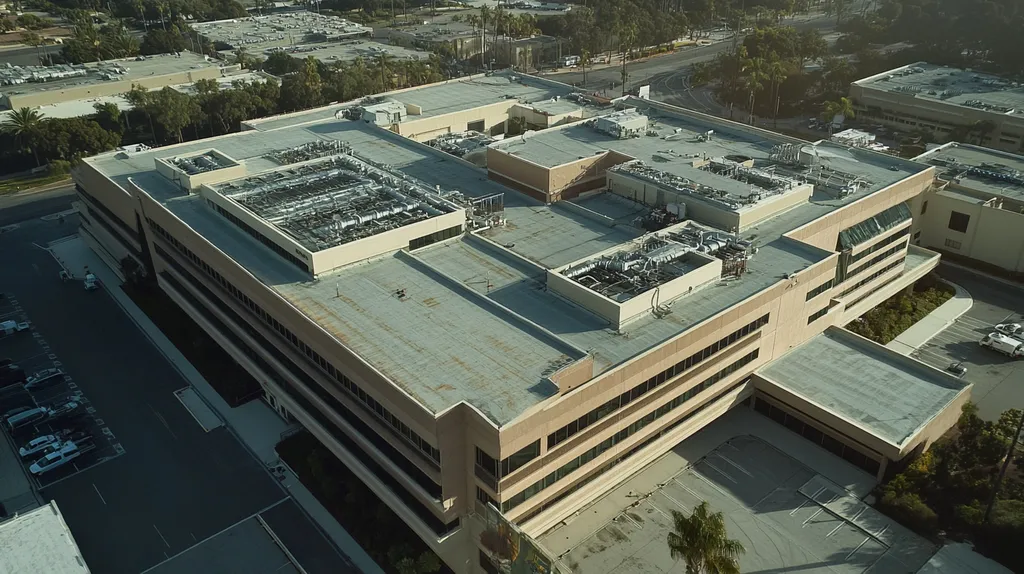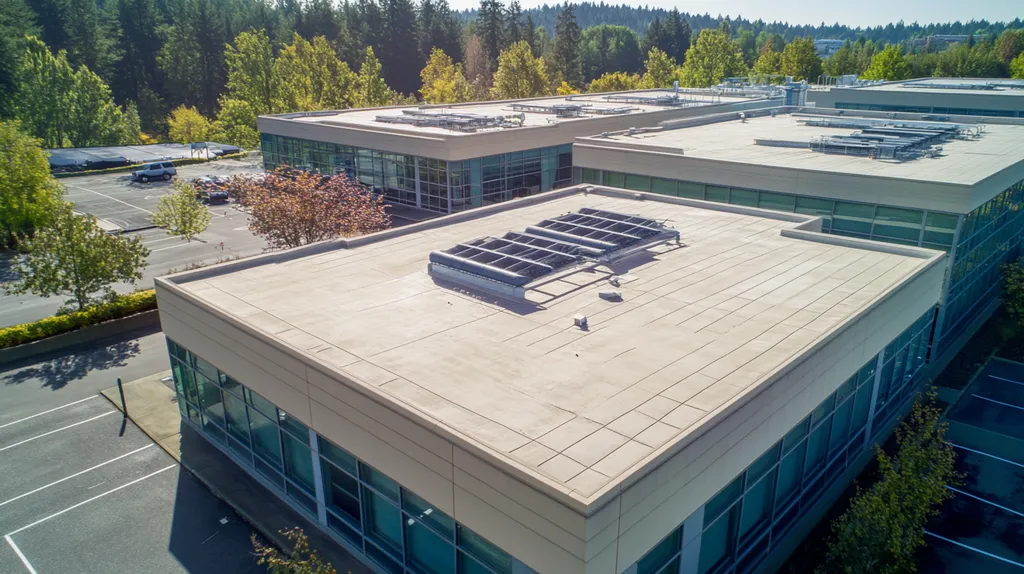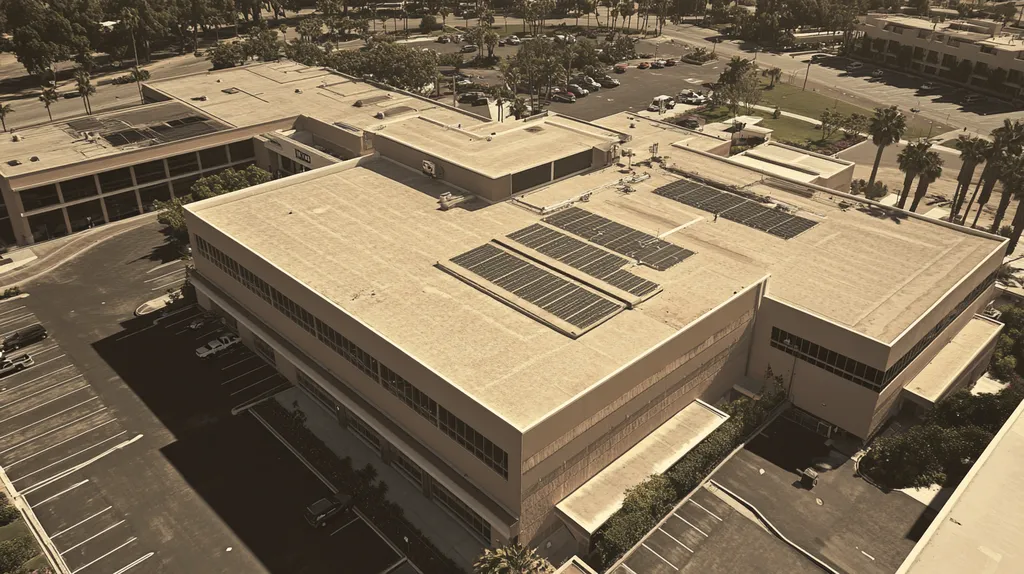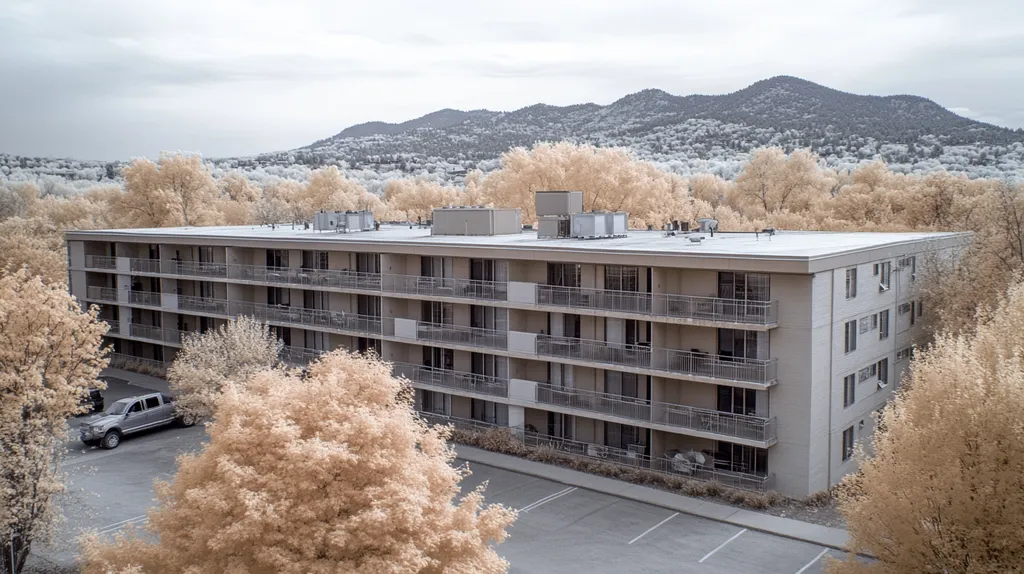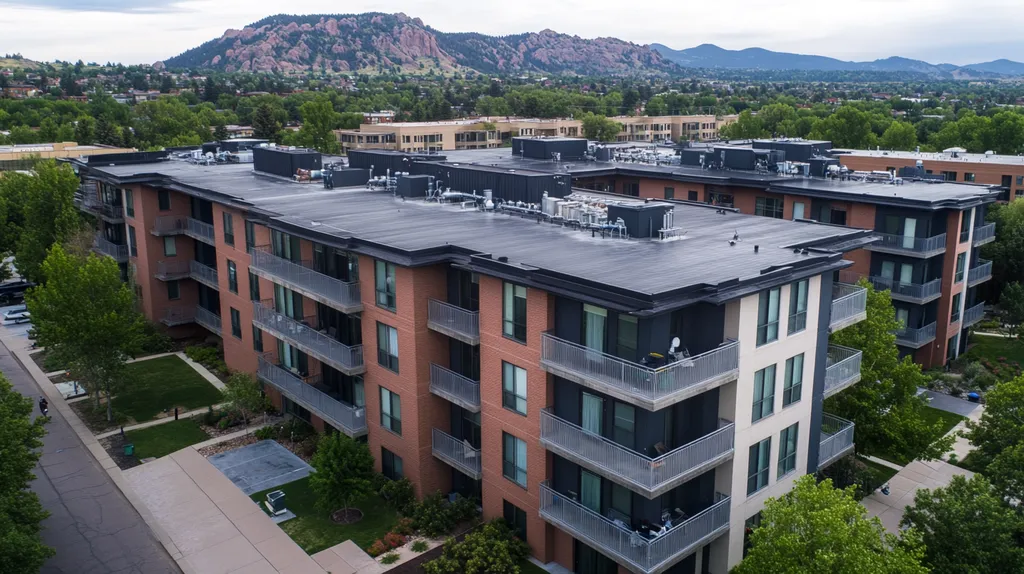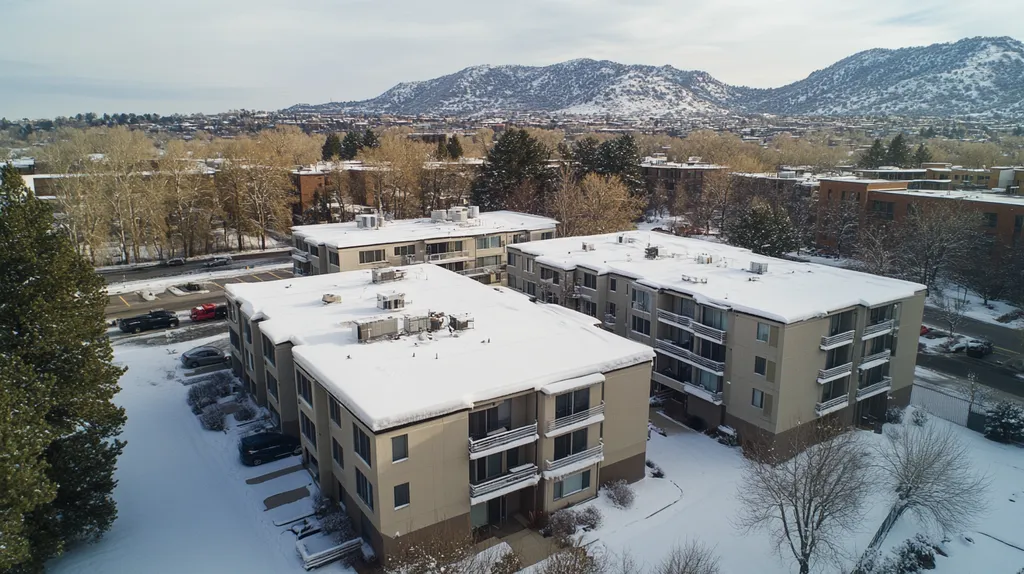In commercial buildings across America, soaring indoor temperatures aren’t just an annoyance—they’re a profit killer. Studies show that workplace productivity plummets by up to 20% when indoor temperatures exceed 77°F, costing businesses billions annually in lost efficiency.
While facility managers wrestle with skyrocketing energy bills, the real culprit often lurks overhead: inefficient roofing that turns buildings into solar ovens. Modern roof temperature management isn’t just about comfort—it’s about protecting bottom lines and maintaining operational efficiency.
This guide cuts through the marketing hype to deliver actionable strategies for keeping your commercial space cool, your energy costs down, and your workforce productive during the sweltering summer months.
SECTION 1: THE BASICS EXPLAINED
In the sweltering summer months, commercial roofs can turn into heat magnets, driving indoor temperatures dangerously high. This doesn’t just harm comfort; it impacts energy bills, reduces employee productivity, and threatens sensitive equipment. For building owners aiming for efficiency and comfort, grasping the nuts and bolts of roof temperature management is essential. This section breaks down what roof temperature management means, why it matters, and how it’s scientifically backed.
What It Is (In Plain Language)
Roof temperature management is all about using innovative materials and designs to reflect sunlight and minimize heat absorption. Traditional roofing often acts like a heat trap, baking buildings under the sun. In contrast, modern solutions, such as reflective coatings and cool roofing, are engineered to defy this trend and keep roofs cooler.
The benefits are straightforward: more stable indoor temperatures mean less strain on HVAC systems and a more comfortable environment overall. Some key tactics include opting for light-colored roofing or implementing green roofs. These strategies are instrumental in combating urban heat islands and reducing the cooling needs on your building systems.
Ultimately, effective roof temperature management not only enhances energy efficiency but also fosters a healthier indoor climate.
Why It Matters (To Your Building)
Ignoring roof temperature management can lead to skyrocketing energy costs as air conditioning units struggle to keep up with relentless heat. Higher utility bills can slice through a business’s budget like a hot knife through butter, impacting the bottom line.
Additionally, relentless heat can cause wear and tear on HVAC systems, leading to more frequent repairs and a shorter lifespan. These unplanned expenses only amplify the urgency for building owners to take proactive measures.
Moreover, high indoor temperatures can sap employee productivity. Research shows that as temperatures rise, efficiency plummets. Maintaining a comfortable work environment is crucial not just for health, but for enhancing productivity and job satisfaction.
By investing in effective roof temperature management strategies, property owners transform their workplaces into energy-efficient, comfortable, and cost-effective spaces.
How It Works
Roof temperature management hinges on the principles of reflectivity and insulation. Reflective roofing materials send sunlight bouncing away from the building, cutting down on heat absorption, which translates to lower indoor temperatures and decreased cooling demands.
Insulation plays a central role here as well. Thicker insulation and barrier technologies minimize heat transfer, keeping interiors refreshingly cool. This combined strategy of reflecting sunlight and providing robust insulation tackles excessive heat head-on.
Green roofs, another innovative solution, contribute by offering a natural insulation layer while improving air quality. They also help manage water efficiently and boost local biodiversity.
When combined, these methods work synergistically to regulate building temperatures, promoting energy efficiency and reducing environmental impact.
SECTION 2: PRACTICAL APPLICATIONS
As summer temperatures skyrocket, effective roof temperature management becomes a game changer for commercial properties. Buildings are capable of soaking up a staggering 90% of solar radiation, which can send energy costs through the roof—literally. The good news? Implementing smart roofing solutions can lead to cooling energy savings of 20-30%. This section dives into practical applications of roof temperature management, helping business owners keep their indoor climates comfortable and costs in check.
Common Uses & Examples
Roof temperature management isn’t just theoretical; it’s actively transforming various industries. Reflective roofing materials are a top choice for many commercial buildings, capable of slashing heat absorption significantly. These roofs can cool surface temperatures by up to an impressive 50 degrees Fahrenheit, offering much-needed respite on hot days.
Then there’s the trend of green roofs, which cleverly use plants to provide extra insulation and cooling. By shading the roof and soaking up heat, these green spaces not only improve energy efficiency but also enhance the overall aesthetic of a building. And let’s not forget about cool roofs—where urban environments directly benefit from reducing the notorious urban heat island effect.
In sprawling warehouses, high-performance roofing paired with insulation goes a long way in slashing energy use. Such systems champion operational efficiency and ultimately lead to significant savings over time, making good business sense.
When You Need It Most
The clock is ticking when it comes to effective roof temperature management, particularly during the peak summer months. As the mercury rises, HVAC systems face added strain, potentially leading to breakdowns when you can least afford them. Facilities that experience wild temperature swings should adopt a forward-thinking approach to avoid being caught off guard.
Certain industries, such as food storage and pharmaceuticals, can’t afford to let temperatures fluctuate. For them, maintaining specific indoor climates is a matter of preserving quality and preventing financial hits from spoiled products.
Buildings with significant window space or outdated roofing systems can take a hit from excessive heat gain. Investing in better roofing isn’t just about comfort; it’s a strategic safeguard for critical indoor operations during the hottest months.
Interactions With Other Systems
Roof temperature management doesn’t operate in a vacuum; it’s deeply interconnected with other building systems. A well-designed roofing system enhances HVAC efficiency through better thermal regulation and insulation, which helps minimize wear and tear on these systems.
A thoughtfully engineered roof can also affect water drainage systems, mitigating issues like water pooling that can lead to leaks. Protecting a building’s integrity while cutting down maintenance costs is a win-win.
Moreover, energy management systems gain valuable insights from effective roof management, as real-time data on temperature control can lead to optimized energy consumption. When roof temperatures are kept in check, HVAC systems can respond more swiftly to indoor climate needs.
Integrating roof temperature solutions across various systems ultimately drives greater efficiency and results in significant cost savings. It’s a smart investment for any savvy property owner looking to navigate the heat of summer.
SECTION 3: KEY TERMINOLOGY DECODED
For business owners aiming to tackle indoor heat management, a firm grasp of roofing terminology is absolutely vital. Misinterpreting these terms could lead to costly choices that inflate your operational expenses. Picture overspending on air conditioning simply because you misunderstood the cooling capabilities of your roofing materials. In this section, we break down the essential vocabulary you need to navigate effective roof temperature management with confidence.
Essential Terms Explained
In commercial roofing, certain key terms are directly tied to effective heat management strategies. Take “reflectivity,” for example. This refers to a roof’s knack for bouncing sunlight away. The higher the reflectivity, the less heat infiltrates your building, keeping it cooler inside. Then there’s “thermal mass,” a concept that measures how well a material can absorb and hold onto heat. Understanding these terms equips property owners to make informed choices about materials that help reduce heat.
“Cool roofing” is another buzzword worth knowing. This term encompasses various materials designed to enhance energy efficiency, often featuring reflective coatings or inherently reflective materials. By incorporating cool roofs, businesses can significantly drop indoor temperatures, leading to savings on energy costs and improved comfort for everyone inside.
Also on the list is “insulation,” a critical player in temperature control. Proper insulation acts as a barrier against heat transfer, helping to keep buildings cooler in summer and warmer in winter. Mastering these essential terms enhances communication between facility managers and roofing contractors, ensuring better project outcomes.
Industry Jargon Translated
The roofing world is infamous for its jargon, which can sometimes feel like a secret language. Let’s demystify “R-value,” for instance. This measurement indicates a roof’s thermal resistance, or how well it insulates against heat. Higher R-values mean better insulation, which is crucial for controlling energy costs and enhancing comfort.
Next on the list is “UV degradation.” This term describes the wear and tear that roofing materials experience due to exposure to ultraviolet rays. Such degradation can shorten a roof’s lifespan and diminish its insulating effectiveness, underscoring the importance of routine maintenance and possibly upgrading to UV-resistant materials.
Lastly, we can’t forget about “ventilation.” Effective roof ventilation helps prevent heat buildup, which can lead to inflated cooling costs. Understanding these terms is essential for all stakeholders, helping them navigate their roofing options and understand the benefits associated with each.
Measurement & Units Simplified
When delving into roof temperature management, a few key measurements and units come into play. “Degree Fahrenheit” (°F) is the standard for measuring temperature, while “BTU” (British Thermal Unit) measures energy consumption. Grasping how these units connect to heat management is crucial for measuring the energy savings different roofing solutions can provide.
“Solar reflectance” is another vital measurement, expressed as a percentage. It tells you how much sunlight your roof reflects compared to how much it absorbs. For example, a roof with a solar reflectance of 70% reflects 70% of sunlight, directly impacting indoor heat levels and overall building comfort.
Understanding these measurements enables facility managers to make more informed decisions, ensuring they choose roofing solutions that optimize their business’s efficiency and enhance indoor comfort. By breaking down these complex units, we empower property owners to make savvy choices in roof temperature management.
SECTION 4: DECISION FACTORS
As summer temperatures soar, property owners face the relentless challenge of rising indoor heat, pushing business operations to the brink. Effective roof temperature management isn’t just a smart choice; it’s essential for keeping cooling costs down and employee comfort high. However, navigating through cost considerations, performance trade-offs, and durability factors can feel like a daunting maze. Understanding these elements is crucial for making informed roofing decisions that align with overall business strategies and goals.
Cost Considerations
Investing in high-performance roofing might seem like a hit to the budget, but consider the long game. Although the initial price tag can be steep, reflective roofing materials have the potential to chop cooling costs by up to 30% during the sweltering summer months. Trade-offs are part of the game, but in this case, the payoff can be a substantial win for your wallet.
Financing options abound, including potential tax incentives and rebates that help offset those upfront costs. Don’t forget about the long-term benefits, either—less frequent maintenance translates to lower repair bills over time, making this investment pay off even more.
Your roofing choices can also impact insurance premiums. A roof designed to combat heat can make property owners eligible for reduced insurance rates, thanks to the lower risk of heat-related damage. That’s a win-win scenario.
While the initial costs can be intimidating, the long-term savings and potential financial perks often justify diving into superior roofing technologies.
Performance Trade-offs
Choosing roofing materials isn’t all sunshine and rainbows—performance trade-offs are key players in this complex game. Budget-friendly options might tempt owners, but many lack the insulation and reflectivity needed to keep the indoor climate cool. The results? Higher cooling demands and less energy efficiency, which is a recipe for disaster.
It’s important to remember that not all roofing systems are created equal. Some might shine in durability but fall flat on sunlight reflection, creating a heat burden that your cooling systems will hate.
Assessing insulation, reflectivity, and ventilation is vital. Performance metrics shouldn’t stop at initial cost; consider lifecycle costs to understand how well a system performs from installation through its years of service.
A roof that excels in thermal performance might require premium materials, but investing in quality translates to lower energy consumption and greater building comfort.
Lifespan & Durability Factors
The lifespan of your roofing system plays a pivotal role in overall costs and efficiency. Short-lived roofs can become a money pit, requiring premature replacements that add up over time and contribute to landfill waste. A durable roof, on the other hand, can endure 20 years or more when cared for properly.
Weather resistance is equally important. Roofs designed to brave extreme temperatures and storms aren’t just a luxury; they ensure longevity and optimal performance, which is crucial for effective indoor temperature management.
Additionally, considering warranties covering thermal performance is non-negotiable. A solid warranty not only strengthens your investment but protects you from unexpected issues down the road.
In conclusion, examining lifespan and durability factors allows property owners to select roofing systems that stand strong against time and environmental challenges. This foresight helps safeguard finances while promoting a comfortable workplace.
SECTION 5: COMMON CHALLENGES
As summer’s relentless heat beats down on commercial buildings, indoor temperatures can skyrocket, wreaking havoc on both productivity and energy bills. Research shows that high indoor temperatures can sap productivity by as much as 20%. For property owners and facility managers, it’s critical to identify and understand the common challenges of roof temperature management. This section will highlight frequent issues, important warning signs to keep an eye on, and effective preventative measures to maintain a comfortable and efficient indoor environment.
Frequent Problems & Solutions
Inadequate insulation is a frequent headache in commercial roofing. When insulation is lacking, heat creeps into the building, sending indoor temperatures and energy costs soaring. The fix? Conduct thorough inspections and consider upgrading to high-performance insulation materials that can handle the heat.
Reflective roof deterioration is another common culprit. A roof that loses its ability to reflect sunlight becomes a heat sponge, trapping warmth indoors. The solution lies in regular maintenance and, when necessary, re-coating with fresh reflective materials to restore that energy-saving sheen.
Leaks and moisture intrusion are more than just minor annoyances—they can severely impair roof performance and worsen indoor heat retention. Prompt repairs and the installation of water-resistant barriers can fortify roofs against leaks, preventing bigger headaches down the line.
Lastly, outdated or poorly maintained HVAC systems can intensify indoor heat issues. If air conditioning struggles to keep spaces cool, it’s time to consider an upgrade or at least ensure regular maintenance to enhance climate control.
Warning Signs To Watch For
Condensation forming on indoor surfaces is a serious red flag for roof temperature problems. This dampness often points to excessive humidity levels—a telltale sign of insufficient insulation or ventilation. Property owners need to tackle these issues before they snowball into larger problems.
Soaring energy bills during the heatwave months should raise alarms as well. If energy costs spike unexpectedly, it might indicate that the roofing system is falling short in regulating temperature. An energy audit can provide insight into the underlying issues needing attention.
Hot spots within a building signal uneven heat distribution, often due to inadequate insulation or air circulation issues. If certain areas are persistently sweltering while others remain blissfully cool, it’s time to investigate and resolve these irregularities.
Lastly, keep a close eye on the roof itself. Visible wear and tear—like cracks or blistering—can lead to increased heat absorption and energy inefficiencies. These physical signs should prompt immediate action to prevent bigger challenges.
Preventative Approaches
A proactive approach starts with a regular inspection schedule. Routine assessments can catch early warning signs of trouble, staving off costly repairs and maintaining roof performance. Inspections should thoroughly check insulation, reflective surfaces, and the overall condition of the roof.
Investing in high-quality, reflective roofing materials is another smart preventative measure. These materials drastically cut down on heat absorption, ensuring more consistent indoor temperatures during the sweltering summer months.
Enhancing ventilation systems is equally crucial. Proper ventilation works hand-in-hand with roofing strategies by allowing hot air to escape and enabling cooler air to circulate, maintaining comfort throughout the space.
Lastly, don’t overlook the importance of HVAC system maintenance. Regular upkeep keeps cooling systems running at peak performance, supporting the overall indoor climate control strategy and ensuring a comfortable atmosphere for everyone inside.
SECTION 6: NEXT STEPS & RESOURCES
Summer heat can turn commercial buildings into ovens, making inadequate roofing solutions feel like an invitation to skyrocketing temperatures and costs. Rising indoor temperatures can impact employee comfort, productivity, and ultimately affect the bottom line. But fear not! With the right information and a proactive approach, property owners and facility managers can implement robust roofing strategies. This section lays out vital questions for engaging roofing providers, outlines necessary industry standards, and points to resources for further learning.
Questions To Ask Providers
When it comes to selecting roofing providers, property owners can’t afford to be passive. Start by asking pointed questions: What materials do you recommend for heat resistance? Material choices are crucial for temperature regulation.
Next, dig into how their installation process minimizes energy consumption. The method of installation can greatly impact long-term efficiency. Additionally, inquire about the lifespan and maintenance needs of their proposed roofing systems. Long-lasting materials can save big on replacement costs.
Don’t skip reviewing past client references to gauge satisfaction levels. Finally, clarify whether they offer warranties covering energy efficiency metrics—this will hold them accountable for what they promise.
Posing these questions will not only test the provider’s expertise but also ensure they align with your objective of reducing indoor temperatures.
Industry Standards & Guidelines
Acquainting yourself with industry standards is critical for making informed roofing choices. Take a look at organizations like the Cool Roof Rating Council (CRRC), which provide guidelines to assess the performance of reflective roofing materials. These standards help you choose coatings that can deliver significant reductions in surface temperatures.
The American Society for Testing and Materials (ASTM) also lays down specifications for various roofing materials, ensuring compliance with industry benchmarks. Getting familiar with these specs can guide you toward high-performance roofing solutions.
Moreover, the U.S. Department of Energy provides valuable insights on energy-efficient roofing that align with national energy conservation goals. Sticking to these standards maximizes energy savings while improving your indoor climate control.
Further Learning Simplified
For ongoing education, property owners and facility managers have access to a treasure trove of online resources. Websites like Energy Star offer essential information on energy-efficient building practices and roofing solutions that fend off heat retention.
Catch up on free webinars hosted by industry leaders for the latest tech and trends. Also, consider jumping into professional organizations like the National Roofing Contractors Association to enhance your knowledge through networking and educational opportunities.
These organizations often list required certifications for contractors, aiding in your hiring decisions. Lastly, staying updated via industry publications will keep stakeholders informed about advancements in roofing technology. This proactive approach ensures property owners stay ahead of the curve in effectively managing summer heat.
The Bottom Line
With workplace productivity plummeting up to 20% in overheated buildings and energy costs continuing to surge, effective roof temperature management isn’t optional—it’s mission-critical for modern businesses.
Smart roofing choices can slash cooling costs by 30% while creating more comfortable, productive workspaces.
The writing is on the wall: traditional black roofs that turn buildings into solar ovens are becoming corporate liability in an era of climate change and rising energy prices.
Property owners who invest in temperature-smart roofing solutions now position themselves to reduce operational costs, boost workforce productivity, and future-proof their facilities against increasingly extreme summer temperatures.
The real question isn’t whether to upgrade your roof’s temperature management—it’s whether you’ll do it before your competition does.
FREQUENTLY ASKED QUESTIONS
Q. What is roof temperature management for a commercial roof?
A. Roof temperature management involves using materials and designs that reflect sunlight and reduce heat absorption. Traditional roofs trap heat, making buildings uncomfortable and expensive to cool. Modern solutions focus on enhancing energy efficiency, keeping indoor temperatures stable, and easing the burden on HVAC systems. It’s about ensuring your building doesn’t turn into a sauna during summer.
Q. How can I apply roof temperature management with an industrial roof?
A. Smart roofing solutions can provide cooling energy savings of 20-30%. Implementing reflective materials or green roofs can drastically reduce heat absorption. High-performance roofing combined with insulation further cuts energy costs. It’s like putting a cool hat on your building and saving money while keeping everyone inside comfortable during the summer heat.
Q. What key terms should I know about commercial roofs?
A. Familiarizing yourself with terms like “reflectivity,” “thermal mass,” and “cool roofing” is essential. Reflectivity measures how well a roof bounces sunlight, while thermal mass relates to how materials retain heat. Cool roofing covers materials that boost energy efficiency and minimizes heat absorption. Mastering these terms helps avoid costly misunderstandings when shopping for roofing solutions.
Q. What factors should I consider for my commercial roof decision?
A. When considering a roof, assess costs, performance trade-offs, and durability. While high-quality roofing may have a heftier price tag upfront, it can cut your cooling costs significantly over time. Look for materials that balance insulation and reflectivity without sacrificing longevity. Your choice now can protect your wallet later, so don’t be overly frugal!
Q. What common challenges do commercial roofs face?
A. Frequent problems include inadequate insulation, reflective roof deterioration, and moisture leaks. Without proper insulation, heat will intrude, driving costs and discomfort up. Regular maintenance and inspections can catch these issues early. Don’t ignore signs like condensation or rising energy bills; they often mean it’s time to take action to keep your building cool.
Q. How can I engage roofing providers for my industrial roof?
A. Ask providers about their recommended materials for heat resistance and energy efficiency. Explore their installation processes, lifespan expectations, and maintenance requirements. Look into their past projects to gauge their reliability, and ensure they offer warranties that cover energy efficiency metrics—no one likes being left out in the sun with a lemon roof!
Q. What are some innovative roofing solutions not widely known?
A. One innovative solution is the use of “living roofs,” where vegetation is planted on rooftops to insulate and cool buildings naturally. These roofs not only combat heat but also enhance biodiversity and stormwater management. Another option is installing phase-change materials that absorb excessive heat during the day and release it at night, keeping the building comfortable around the clock.

